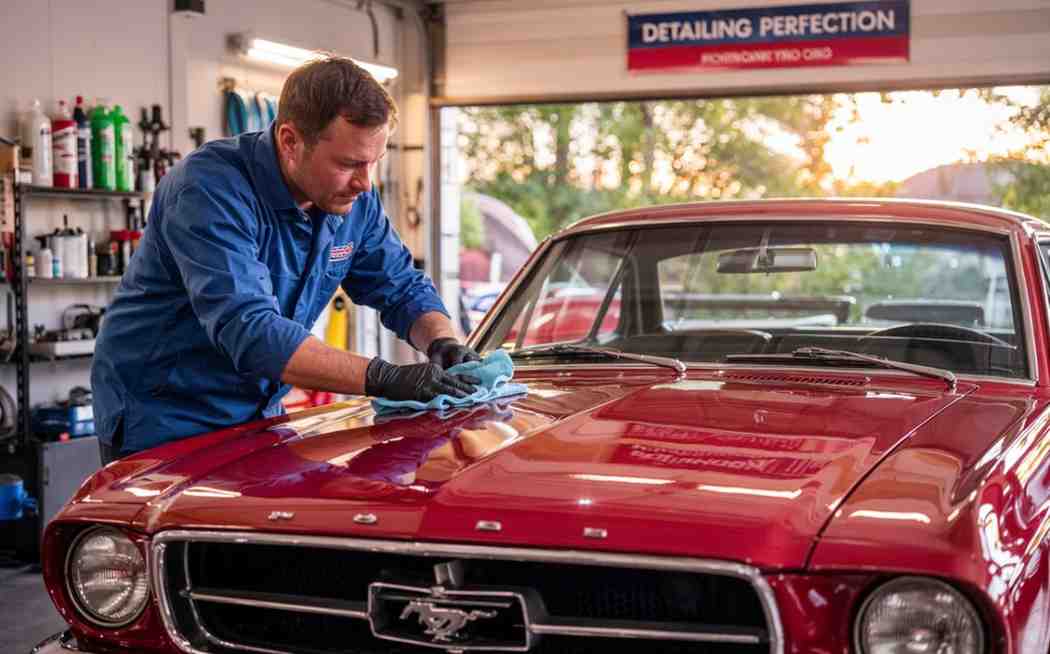Maintaining a car is more than just making it shine—it’s about preserving its value, improving performance, and ensuring a comfortable driving experience. That’s where car detailing comes into play. However, many people are confused about the difference between interior and exterior detailing and often wonder whether both are necessary. In this blog, we’ll dive deep into what is interior detailing, what is exterior detailing, and help you clearly understand the difference between interior and exterior detailing so you can make the best decisions for your vehicle’s care.
What Is Interior Detailing?
So, what is interior detailing exactly? In simple terms, it involves the deep cleaning and restoration of everything inside your vehicle. This includes seats, carpets, mats, dashboard, center console, door panels, steering wheel, and even air vents.
Professional interior detailing doesn’t just make your car’s interior look and smell fresh; it improves hygiene, reduces allergens, and extends the life of interior materials. Techniques may include:
- Vacuuming: Removes dust, debris, and dirt from seats, floors, and hidden corners.
- Shampooing/Upholstery Cleaning: Deep cleans fabrics and eliminates stains.
- Steam Cleaning: Sanitizes surfaces and eliminates bacteria and germs.
- Leather Treatment: Conditions and protects leather seats to prevent cracking.
- Dashboard and Trim Polishing: Restores shine and protects plastic and vinyl surfaces.
- Odor Elimination: Neutralizes unpleasant smells using ozone treatments or deodorizers.
As you can see, what is interior detailing goes beyond just wiping surfaces. It’s a thorough, restorative process that brings back that “new car feel,” making it a favorite among car owners who care about comfort and cleanliness.
What Is Exterior Detailing?
On the other hand, what is exterior detailing focuses entirely on the outside of your car. It includes a wide range of cleaning and reconditioning tasks to restore and protect the car’s paint, glass, wheels, and trim.
Many people confuse exterior detailing with a regular car wash. While a car wash removes loose dirt and grime, detailing digs much deeper. Here’s what professional exterior detailing often includes:
- Hand Washing: Ensures dirt and contaminants are safely removed without scratching the paint.
- Claying: Removes bonded contaminants like tar, sap, or industrial fallout.
- Polishing: Eliminates swirl marks, oxidation, and minor scratches to restore gloss.
- Paint Protection: Adds wax, sealant, or ceramic coating to shield the paint from UV rays and environmental damage.
- Wheel & Tire Cleaning: Removes brake dust and shines the wheels and tires.
- Glass Cleaning: Leaves your windows and mirrors spotless and streak-free.
Understanding what is exterior detailing helps you realize how crucial it is for preserving your vehicle’s value and enhancing its curb appeal. Regular exterior detailing protects the paintwork and maintains the overall aesthetic of your car.
Difference Between Interior and Exterior Detailing
Now that we’ve explored both sides, it’s time to break down the difference between interior and exterior detailing. While both aim to restore and protect different parts of your car, they serve distinct purposes.
Purpose and Focus
- Interior detailing focuses on cleanliness, comfort, and hygiene inside the car.
- Exterior detailing focuses on appearance, paint preservation, and protection from external elements.
This core difference between interior and exterior detailing affects not only the methods used but also the frequency with which each service should be performed.
Tools and Techniques
- For interior work, professionals use vacuum cleaners, steamers, brushes, and specialized cleaning solutions.
- For exterior detailing, tools like polishers, clay bars, microfiber towels, and detailing sprays are more common.
The types of products used also vary. Leather conditioners and fabric protectants are common in interior detailing, while exterior detailing relies on compounds, waxes, and sealants.
Time and Cost
Interior detailing may take longer depending on how dirty the interior is, especially if there are stains, pet hair, or odors to eliminate. Exterior detailing can vary in time depending on whether it includes paint correction or protective coatings.
As a general rule:
- Interior detailing might cost slightly less but can be more labor-intensive if the car is heavily used.
- Exterior detailing can be more expensive, especially when including services like ceramic coating.
Understanding the difference between interior and exterior detailing helps customers choose the right service based on their car’s condition and personal preferences.
Why You Need Both
While it’s common for people to prioritize the exterior because it’s what others see, neglecting the interior can lead to long-term damage and reduced resale value. Similarly, a clean interior won’t mean much if your paint is faded and the wheels are coated in brake dust.
Combining both interior and exterior detailing ensures your vehicle is maintained inside and out, offering both cosmetic and functional benefits. After all, what’s the point of driving a shiny car with a grimy interior?
If you’ve ever asked, what is interior detailing or what is exterior detailing, the best answer might be: they’re two halves of the same whole. Keeping both in good condition provides a well-rounded car care routine that keeps your car running and looking great.
How Often Should You Detail Your Car?
Frequency depends on your driving habits, the climate, and how much you care about aesthetics. Here’s a general guide:
- Interior detailing: Every 3–6 months, especially if you drive frequently, have kids or pets, or eat in your car.
- Exterior detailing: Every 2–4 months for regular wax protection; annually for paint correction or ceramic coating.
If you live in harsh climates or urban areas with a lot of pollution, more frequent detailing may be necessary to protect your investment.
DIY vs. Professional Detailing
Now that you understand what is interior detailing and what is exterior detailing, you might wonder if it’s worth doing it yourself or hiring a pro.
DIY Detailing is great for basic upkeep, like vacuuming or washing the car. But deep cleaning or paint correction requires skill and equipment.
Professional Detailing offers a thorough and reliable solution with expert-level results. For serious stains, scratches, or long-term protection like ceramic coatings, pros are your best bet.
Detailing Tips for Car Owners
Whether you go DIY or hire a professional, keep these tips in mind:
- Always use microfiber cloths to avoid scratching surfaces.
- Don’t use household cleaners on your car; they can damage surfaces.
- Vacuum before applying any cleaner in the interior.
- Wash your car in the shade to avoid water spots during exterior cleaning.
- Apply fabric protectant after interior cleaning to repel future stains.
Remember, knowing the difference between interior and exterior detailing helps you apply the right care techniques in the right places.
Conclusion
Whether you’re preparing your car for resale or just love a clean, fresh driving environment, both interior and exterior detailing are essential. Understanding what is interior detailing, what is exterior detailing, and the difference between interior and exterior detailing gives you the knowledge needed to make smarter car care decisions.
Detailing your car isn’t just about looks—it’s about protecting your investment, improving comfort, and enhancing your overall driving experience. So, next time you think about giving your car some TLC, don’t just focus on one side. Treat your car to a full-service detailing—inside and out.



